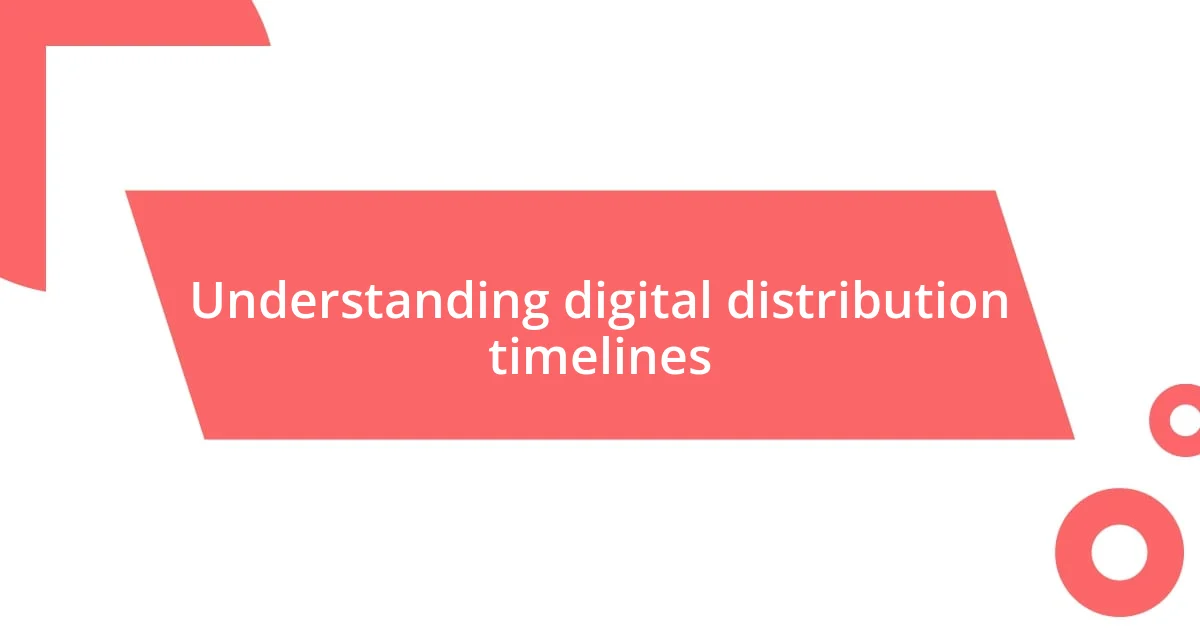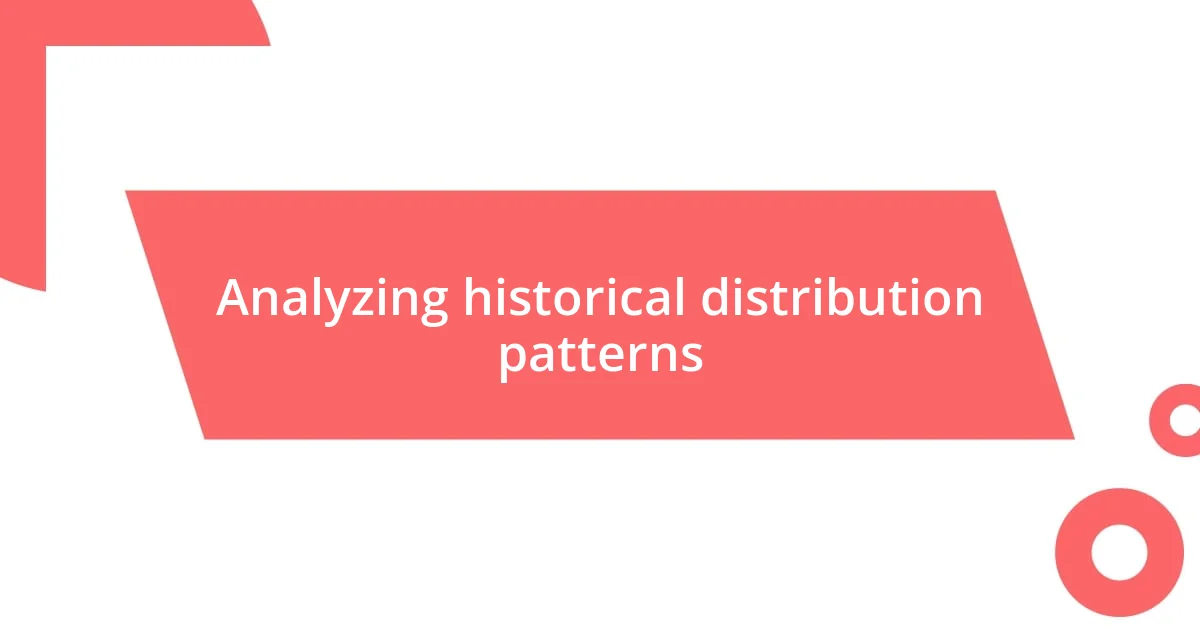Key takeaways:
- Timing significantly impacts audience engagement, with well-timed releases generating excitement, while delays and rushed launches can lead to disappointment.
- Key factors influencing digital distribution timelines include platform choice, quality assurance, and marketing strategies, all requiring careful planning and coordination.
- Future trends in digital distribution include personalized experiences, integration of VR/AR technologies, and an emphasis on sustainable practices to engage consumers more effectively.

Understanding digital distribution timelines
Understanding digital distribution timelines can feel a bit overwhelming at first, but it’s really about grasping the flow of content from creation to consumption. I remember when I first navigated this space; I was surprised by how many variables could affect timings. For example, a simple strategy change could push a release date back by weeks, leaving me on the edge of my seat.
Have you ever wondered why some games release on time while others seem to drag on forever? In my experience, factors like platform certification processes, technical adjustments, and even marketing schedules play a huge role. I was once involved in a project where we needed additional testing because a game-breaking bug was discovered just days before launch. Those last-minute fixes can significantly alter the release timeline, but they are often necessary to ensure a polished product.
It’s important to recognize that timing can drastically impact audience engagement and anticipation. I’ve seen firsthand how a well-timed campaign can energize a community, making every delay painful. Conversely, rushing a release can lead to negative feedback, creating a ripple effect that can last for years. Understanding these dynamics has made me more respectful of the intricate planning involved in digital distribution—there’s truly an art to it.

Importance of timely digital releases
Timely digital releases are crucial for generating buzz and ensuring a product’s success. I recall a game launch I eagerly anticipated; it aligned perfectly with a major gaming convention. The excitement in the air was palpable, and the timely release amplified our community’s enthusiasm. When products hit the market at just the right moment, it fuels conversations and fosters a sense of community engagement. There’s a shared thrill when everyone experiences something simultaneously.
- Timely releases capitalize on trending moments or seasonal events, enhancing visibility and relevance.
- Delays can lead to loss of interest and a fragmented community, as excitement wanes with waiting.
- Properly timed launches improve media coverage, as journalists are more likely to showcase new releases that align with current events or gaming expos.
On the flip side, I’ve learned that rushing can lead to disappointing outcomes. Once, a beloved franchise rushed a sequel, and the backlash from fans was intense. It was disheartening to see the disappointment overshadow the excitement. Consumers have high expectations, and when those aren’t met, it can sour what was once a joyful experience. Understanding this delicate balance of timing is vital—it’s not just about getting products out the door but making sure they resonate with audiences.

Factors affecting digital distribution
Digital distribution is influenced by numerous factors that are often intertwined. For instance, the choice of distribution platform can impact a product’s reach and visibility. I vividly remember a project where we decided to launch on multiple platforms simultaneously, maximizing exposure and engagement. However, this decision required careful coordination to meet various technical requirements, and the planning phase took longer than expected.
Another critical factor is the quality assurance process, which ensures that the product meets all standards before launch. In one of my experiences, we encountered unexpected localization issues that needed to be rectified, pushing our timeline back. It reminded me that each delay, while frustrating, served a purpose in delivering a better experience for the end-user.
Moreover, marketing strategies play a significant role in shaping distribution timelines. I once participated in a release where our marketing team strategically chose to initiate a pre-launch campaign, creating buzz that effectively prepped our audience. This timing allowed us to gauge interest and adjust promotions, ensuring we connected with our audience right when they were most receptive.
| Factor | Description |
|---|---|
| Platform Choice | The distribution platform impacts visibility and reach; launching on multiple platforms can broaden audience engagement but complicate coordination. |
| Quality Assurance | Ensures the product meets standards before launch; issues in this phase can lead to delays but ultimately improve the end-user experience. |
| Marketing Strategy | Well-timed marketing campaigns can create buzz and gauge audience interest; timing marketing efforts is crucial for effective engagement. |

Analyzing historical distribution patterns
Analyzing historical distribution patterns reveals that many successful products leveraged key moments in culture or industry trends to launch. I remember watching the gaming community rally around releases that dropped alongside highly anticipated events, like E3 or significant anniversaries. It made me wonder—why do some companies manage to nail their timing while others fall flat? The answer often lies in their ability to read the room and understand their audience’s desires.
Reflecting on the past, I’ve seen examples where delayed launches caused a ripple effect of disappointment. There was a time when a beloved game franchise postponed its release due to technical issues. The initial frustration among fans morphed into worry about whether the game would live up to expectations. It struck me how a fragile connection can easily be disrupted, and it made me think—can a company ever truly recover from misjudging timing?
When I analyze distribution patterns, the importance of historical context becomes evident. Successful timelines sport a blend of intuition and data analysis. One of my favorite case studies involves a smaller indie game that launched unexpectedly during a quiet month. It caught everyone off guard and quickly gained traction, proving that sometimes, breaking from the crowd can yield incredible results. Moments like this make me ask—what would happen if we all dared to challenge the status quo in our distribution strategies?

Strategies for optimizing release schedules
Timing is everything, and I’ve learned that slotting releases strategically can make a huge difference. I recall a project where we unveiled a new digital product right before the holiday shopping rush. It wasn’t merely about the product but how we positioned it in a moment when our target audience was eager to spend. That’s a prime example of using external factors to your advantage.
Another aspect I’ve found effective is the iterative planning approach. When we worked on a major update for our app, we broke the schedule down into bite-sized milestones. This allowed us to gather feedback before each release phase, which not only kept our audience engaged but also helped us make necessary adjustments along the way. Isn’t it amazing how flexibility can turn a rigid timeline into a living, breathing plan?
Lastly, collaborating closely with marketing from the get-go has been a game changer. In one instance, the marketing team pitched a release during a trending online event, which not only aligned our visibility with popular discussions but also sparked organic conversations. This timely synergy taught me that a well-linked effort among teams can amplify impact and make your release date feel like a celebration rather than a mere deadline. Can you think of a time when two teams in your projects aligned perfectly, creating a memorable moment?

Future trends in digital distribution
As I look to the future, one trend I find intriguing is the rise of personalized digital distribution. Companies are increasingly leveraging data analytics to understand individual consumer preferences and habits. I once witnessed a streaming service tailor its recommendations based on viewing patterns, which not only boosted user engagement but transformed the entire user experience into a targeted journey. Have you ever felt like a service just knew what you wanted before you did? That’s the power of personal touch in distribution.
Another emerging trend is the blending of virtual reality (VR) and augmented reality (AR) with digital distribution. I recall experimenting with an AR app that let users try on virtual merchandise before purchasing. This immersive experience created a deeper emotional connection between consumers and products, leading to higher satisfaction. Isn’t it exciting to think about how these technologies will redefine how we discover and buy products in the near future?
I also see the importance of sustainable practices influencing digital distribution strategies. More organizations are prioritizing eco-friendly methods, such as reducing data center energy consumption or opting for carbon offset programs. When I engaged with a company committed to sustainability, their transparent approach resonated with me and their customer base, reinforcing loyalty and trust. Isn’t it fascinating to consider how making conscious choices can attract consumers who share those values?















